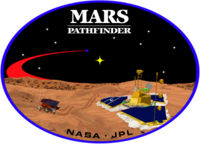Mars Pathfinder
Overview
This NASA mission was launched on a Delta II rocket on December 4, 1996. The Mars Pathfinder mission was used to demonstrate that NASA could send an exploratory mission to Mars for 1/15th of the cost of the Viking budget in the 1970's. The mission was developed at a cost of under $150 million in 3 years. Mars Pathfinder landed in Ares Vallis, Chryse Planitia, at 19 degrees 7'48" N and 33 degrees 13'12"W. This location is in the Oxia Palus quadrangle.[1] [2]
One of the major mission objectives was to deliver a microrover safely to the surface in order to study the surface composition. The microrover onboard was known as Sojourner. Rocks and soil were probed with an Alpha Proton X-ray Spectrometer (APXS),[3] The name Sojourner was selected in a contest that was won by Vallery Ambroise, a 12-year-old from Connecticut. It is named for Sojourner Truth, an abolitionist and women's rights activist. Sojourner first appeared in print in the Bible in the first chapter of Genesis. It deals with the travels of Abraham; it means "traveler."[4] Sojourner was powered with solar panels and a non-rechargeable battery, which greatly limited night time activities. When the batteries were depleted, it could not work at night.[5] Its lithium-thionyl chloride (LiSOCl2) batteries only generated 150 watt-hours.[6]
The Mars Pathfinder Mission lasted from December 1996 to March 1998. It greatly surpassed its expectations by returning 2.3 billion bits of information, including over 17,000 images. pathfinder carried out more than 15 chemical analyses of rocks and soil, besides collecting data on the weather. Information learned through the mission suggest that, in its past, Mars was warm and wet, with liquid water on its surface and a thicker atmosphere. Depletion of the spacecraft's battery along with a drop in the spacecraft's operating temperature were believed to be why we lost communications with Pathfinder in October 1997. The mission far surpassed its expected 30-day lifetime.[7]
[[File:Pathfinder-airbag-landing-concept.jpg|thumb|left|200px|Pathfinder was surrounded by giant air bags for its landing. It bounced at least 15 times and up to 12 meters high before it came to rest.Cite error: Closing </ref> missing for <ref> tag
[[Image:PIA01153 20594.jpg|thumb|400px|right|Annotated panorama of the Ares Vallis landing site of the Mars Pathfinder lander. Annotations of surrounding features and rocks identified by the Pathfinder mission team.]]
References
- ↑ https://en.wikipedia.org/wiki/Mars_Pathfinder
- ↑ https://www-k12.atmos.washington.edu/k12/mars/MPF_short_facts.html
- ↑ Cite journal |title=Determination of the chemical composition of Martian soil and rocks: The alpha proton X ray spectrometer |author1=R. Rieder |author2=H. Wänke |author3=T. Economou |author4=A. Turkevich |journal= Journal of Geophysical Research |date= 1997 |volume= 102 |pages=4027–4044 |doi=10.1029/96JE03918 |
- ↑ https://mars.jpl.nasa.gov/MPF/rover/name.html
- ↑ https://mars.jpl.nasa.gov/MPF/rover/faqs_sojourner.html
- ↑ cite web|url=http://mars.jpl.nasa.gov/MPF/rover/descrip.html%7Ctitle=Description of the Rover Sojourner|
- ↑ https://mars.nasa.gov/odyssey/files/odyssey/odysseyarrival1.pdf
External Links
- Mars Pathfinder web site - Main entry, links to:
Further Reading
- Golombek, M. et al. 1997. Overview of the Mars Pathfinder Mission and Assessment of Landing Site Predictions. Science: 278. pp. 1743–1748.
-Smith, P. et al. 1997. Results from the Mars Pathfinder Camera. Science: 278. 1758-1765.
-Hviid, S. et al. 1997. Magnetic Properties Experiments on the Mars Pathfinder Lander: Preliminary Results. Science:278. 1768-1770.
-Bruckner, J., G. Dreibus, R. Rieder, and H. Wanke. 2001. Revised Data of the Mars Pathfinder Alpha Proton X-ray spectrometer: Geochemical Behavior of Major and Minor Elements. Lunar and Planetary Science XXXII







